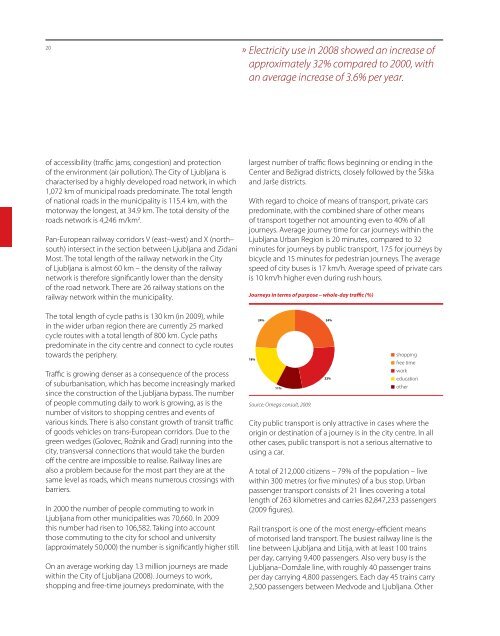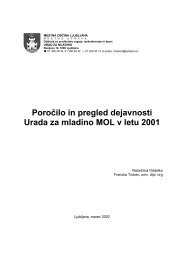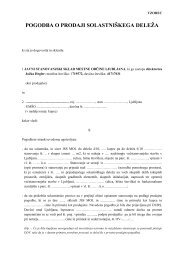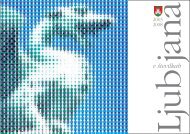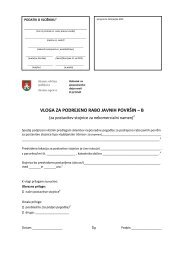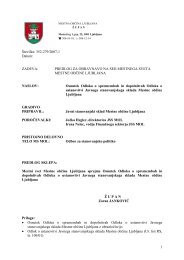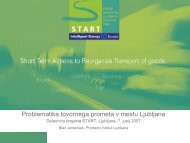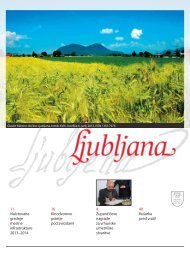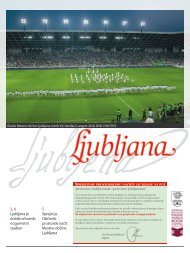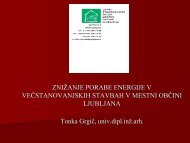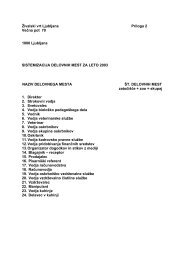Energy for the City of the Future - Ljubljana
Energy for the City of the Future - Ljubljana
Energy for the City of the Future - Ljubljana
Create successful ePaper yourself
Turn your PDF publications into a flip-book with our unique Google optimized e-Paper software.
20<br />
» Electricity use in 2008 showed an increase <strong>of</strong><br />
approximately 32% compared to 2000, with<br />
an average increase <strong>of</strong> 3.6% per year.<br />
<strong>of</strong> accessibility (traffic jams, congestion) and protection<br />
<strong>of</strong> <strong>the</strong> environment (air pollution). The <strong>City</strong> <strong>of</strong> <strong>Ljubljana</strong> is<br />
characterised by a highly developed road network, in which<br />
1,072 km <strong>of</strong> municipal roads predominate. The total length<br />
<strong>of</strong> national roads in <strong>the</strong> municipality is 115.4 km, with <strong>the</strong><br />
motorway <strong>the</strong> longest, at 34.9 km. The total density <strong>of</strong> <strong>the</strong><br />
roads network is 4,246 m/km 2 .<br />
Pan-European railway corridors V (east–west) and X (north–<br />
south) intersect in <strong>the</strong> section between <strong>Ljubljana</strong> and Zidani<br />
Most. The total length <strong>of</strong> <strong>the</strong> railway network in <strong>the</strong> <strong>City</strong><br />
<strong>of</strong> <strong>Ljubljana</strong> is almost 60 km – <strong>the</strong> density <strong>of</strong> <strong>the</strong> railway<br />
network is <strong>the</strong>re<strong>for</strong>e significantly lower than <strong>the</strong> density<br />
<strong>of</strong> <strong>the</strong> road network. There are 26 railway stations on <strong>the</strong><br />
railway network within <strong>the</strong> municipality.<br />
The total length <strong>of</strong> cycle paths is 130 km (in 2009), while<br />
in <strong>the</strong> wider urban region <strong>the</strong>re are currently 25 marked<br />
cycle routes with a total length <strong>of</strong> 800 km. Cycle paths<br />
predominate in <strong>the</strong> city centre and connect to cycle routes<br />
towards <strong>the</strong> periphery.<br />
Traffic is growing denser as a consequence <strong>of</strong> <strong>the</strong> process<br />
<strong>of</strong> suburbanisation, which has become increasingly marked<br />
since <strong>the</strong> construction <strong>of</strong> <strong>the</strong> <strong>Ljubljana</strong> bypass. The number<br />
<strong>of</strong> people commuting daily to work is growing, as is <strong>the</strong><br />
number <strong>of</strong> visitors to shopping centres and events <strong>of</strong><br />
various kinds. There is also constant growth <strong>of</strong> transit traffic<br />
<strong>of</strong> goods vehicles on trans-European corridors. Due to <strong>the</strong><br />
green wedges (Golovec, Rožnik and Grad) running into <strong>the</strong><br />
city, transversal connections that would take <strong>the</strong> burden<br />
<strong>of</strong>f <strong>the</strong> centre are impossible to realise. Railway lines are<br />
also a problem because <strong>for</strong> <strong>the</strong> most part <strong>the</strong>y are at <strong>the</strong><br />
same level as roads, which means numerous crossings with<br />
barriers.<br />
In 2000 <strong>the</strong> number <strong>of</strong> people commuting to work in<br />
<strong>Ljubljana</strong> from o<strong>the</strong>r municipalities was 70,660. In 2009<br />
this number had risen to 106,582. Taking into account<br />
those commuting to <strong>the</strong> city <strong>for</strong> school and university<br />
(approximately 50,000) <strong>the</strong> number is significantly higher still.<br />
On an average working day 1.3 million journeys are made<br />
within <strong>the</strong> <strong>City</strong> <strong>of</strong> <strong>Ljubljana</strong> (2008). Journeys to work,<br />
shopping and free-time journeys predominate, with <strong>the</strong><br />
largest number <strong>of</strong> traffic flows beginning or ending in <strong>the</strong><br />
Center and Bežigrad districts, closely followed by <strong>the</strong> Šiška<br />
and Jarše districts.<br />
With regard to choice <strong>of</strong> means <strong>of</strong> transport, private cars<br />
predominate, with <strong>the</strong> combined share <strong>of</strong> o<strong>the</strong>r means<br />
<strong>of</strong> transport toge<strong>the</strong>r not amounting even to 40% <strong>of</strong> all<br />
journeys. Average journey time <strong>for</strong> car journeys within <strong>the</strong><br />
<strong>Ljubljana</strong> Urban Region is 20 minutes, compared to 32<br />
minutes <strong>for</strong> journeys by public transport, 17.5 <strong>for</strong> journeys by<br />
bicycle and 15 minutes <strong>for</strong> pedestrian journeys. The average<br />
speed <strong>of</strong> city buses is 17 km/h. Average speed <strong>of</strong> private cars<br />
is 10 km/h higher even during rush hours.<br />
Journeys in terms <strong>of</strong> purpose – whole-day traffic (%)<br />
18%<br />
24%<br />
11%<br />
Source: Omega consult, 2009.<br />
24%<br />
23%<br />
shopping<br />
free time<br />
work<br />
education<br />
o<strong>the</strong>r<br />
<strong>City</strong> public transport is only attractive in cases where <strong>the</strong><br />
origin or destination <strong>of</strong> a journey is in <strong>the</strong> city centre. In all<br />
o<strong>the</strong>r cases, public transport is not a serious alternative to<br />
using a car.<br />
A total <strong>of</strong> 212,000 citizens – 79% <strong>of</strong> <strong>the</strong> population – live<br />
within 300 metres (or five minutes) <strong>of</strong> a bus stop. Urban<br />
passenger transport consists <strong>of</strong> 21 lines covering a total<br />
length <strong>of</strong> 263 kilometres and carries 82,847,233 passengers<br />
(2009 figures).<br />
Rail transport is one <strong>of</strong> <strong>the</strong> most energy-efficient means<br />
<strong>of</strong> motorised land transport. The busiest railway line is <strong>the</strong><br />
line between <strong>Ljubljana</strong> and Litija, with at least 100 trains<br />
per day, carrying 9,400 passengers. Also very busy is <strong>the</strong><br />
<strong>Ljubljana</strong>–Domžale line, with roughly 40 passenger trains<br />
per day carrying 4,800 passengers. Each day 45 trains carry<br />
2,500 passengers between Medvode and <strong>Ljubljana</strong>. O<strong>the</strong>r


